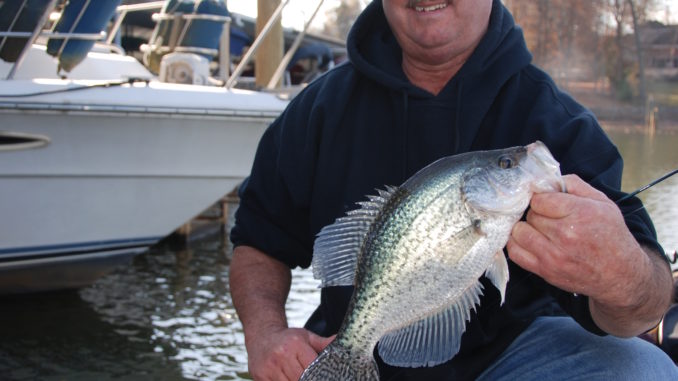
These two anglers shoot jigs rather than bullets when plinking away at Lake Wylie crappie.
Slowly motoring up to a marina in the South Fork River, Mike Parrot cut the controls and eased his trolling motor into the water. A past Crappie Masters national champion from Charlotte, Parrott leaves behind his “heavy artillery” when he’s fishing for fun on home waters of Lake Wylie.
Just like a big-game hunter who enjoys a day of plinking at cans, Parrott heads for the nearest set of boat docks with only a 5 ½-foot ultralight rod in hand.
To catch crappie hiding under the boats and floats that are associated with a good boat dock, Parrott employs the tactic of “shooting” docks — holding the bait, typically a small crappie jig, in one hand while holding the line tight to the spool of an open bail spinning reel with the other.
“It takes a bit of practice,” Parrott said. “You bend the rod over and hold the jig between your thumb and forefinger under the reel. Release the jig and simultaneously release the line, which sling-shots the bait forward, parallel to the water, causing it to skip up under the boat or dock or whatever you’re shooting at.
“My partner and I troll most everywhere we go because we’re out to put the biggest fish we can find in the boat. That’s not to say I don’t catch big crappie shooting docks — especially this time of year when they start staging up for the spawn. But more than anything else, this is a lot of fun, and at the end of the day, it’ll also catch you a bunch of fish.”
Shooting is not a new tactic, but one that many anglers never pursue when “crappie season” rolls around in the spring. Parrott said a lot of crappie stage around boat docks as early as the end of February.
“As soon as it starts warming up, which varies a little from year to year, the fish start to migrate out of deep water back into these creeks, and they’ll stage under the deep-water docks first,” Parrott said. “From there on, you just have to follow the fish. As it warms up, they’ll move on back to shallower docks, and when it comes time to spawn, they’ll get real shallow, maybe four or five feet, depending on the water clarity, and some will spawn under the docks. It’s a great pattern, and (it) will last through the spring.”
In the annals of tournament crappie fishing, Randy Pope stands out above the rest when it comes to shooting docks. Like Parrott, Pope has won several major tournaments by shooting docks. He even tailors his tournament participation around lakes that feature docks in deep water, and Wylie is near the top of his list because it offers not only deep-water docks, but lots of floating docks.
“I think the reason the floating docks are better, more consistent for holding fish year-round than stationary docks, is that they house better water,” said Pope. “When I say better, I mean there’s deeper water from the front to the back than (under) a stationary dock. Most stationary docks are built fairly close to the bank. The best dock that you can find has 20 foot of water in the front of it and 15 foot of water in the back of it.”
Parrott looks to larger, commercial docks like those found in marinas. He said these bigger docks may hold crappie year- round, and all he has to do is move from one end to the other until he finds the depth that’s most attractive to the fish.
“Everything these fish need can be found around these big docks: depth, food, and cover,” Parrott said. “I think these fish even spawn under these docks. All they have to do is move from deeper to shallower as the weather dictates.”
Pope agrees that appropriate water depth is a good dock’s No. 1 factor, but he admits it doesn’t hurt if some good, fish-holding structure is under and around it as well.
“Brush can make a good dock better, but some docks are good just based on their location alone,” Pope said. “Lake Wylie has a good number of residents that fish off their docks; you can tell by the number of rod holders, lights and other signs of fishing activity on many docks.
“My favorite is an isolated dock that provides a lot of shade, is near deep water and may have some natural cover like old stumps or a drop off under it. One of the newer forms of cover are boat lifts; when they are down in the water they can provide a lot of structure and hold fish.”
Both Parrott and Pope prefer to smaller than average jigs, something in the 1/32- to 1/64-ounce range. The primary reason is that crappie will suspend under docks, and a heavier jig will fall past the suspended crappie too quickly, before the fish can react. Being able to detect the bite is another reason that both pros spool up with small-diameter, 4-pound-test line.
“You need a line you can see, because you won’t feel most of the bites you’ll get doing this technique, even with a real good graphite pole. You have to see it,” Parrott said. “You learn to look for a little tension in the line, or maybe the line moves sideways or goes slack all of a sudden. You’ve got to use a line you can see or you’ll miss 95 percent of bites if you’re not watching the line. I prefer a 1/64-ounce jig, because it falls real slow. If the wind’s blowing, sometimes I’ll go up to a 1/32 (ounce).
“The fish can be pretty shallow under the dock. Even if the dock’s over deep water, the fish might only be 3 or 4 feet deep because they’re underneath the shade and don’t have to go down as deep to get out of the sunlight.”
Despite agreeing on how to shoot docks, Pope and Parrott have different ideas on where on Lake Wylie to take aim and fire. Parrott lives on the lake, not far from the South Fork, and that’s where he goes to fish. He even feels that area gives him a jump on dock-shooting season.
“The South Fork is where the stream-plant discharge runs out,” said Parrott. “It’s always warmer in the South Fork than it is over in the Catawba River. That’s why, in late February through March, I’d rather fish from the South Point upriver. Crappie tend to cut on quicker, and they’re more aggressive.”
Pope said he’s fished nearly every dock on Wylie at one time or the other. Without a doubt, his favorite creek is Crowder Creek, just below Buster Boyd Bridge.
“Crowder Creek is No. 1. Boyd’s Cove is on the left going down the lake. That is probably my second most-favorite creek on the lake,” Pope said. “Both will hold a lot of big fish, especially in March, starting to gather up there at the mouths of the creeks. There will be good fish around the docks starting at the mouth of creek in late February and early March and moving further back into the creeks as the month progresses. By the end of March, those fish are going to be in the backs of those creeks. I could fish just those two creeks all month and do well.”
DESTINATION INFORMATION
HOW TO GET THERE/WHEN TO GO: Lake Wylie is a Duke Energy reservoir on the Catawba River, southwest of Charlotte, a portion of which is the border between North and South Carolina. The Buster Boyd Bridge ramp, where US 49 crosses the lake between Charlotte and York, S.C., is a popular access area because it’s at mid-lake. Other public launch sites can be found at www.duke-energy.com/lakes/facts-and-maps/lake-wylie.asp. Good crappie fishing around docks usually cranks up in late February and will last through March into April.
TACTICS/TECHNIQUES: To “shoot” docks, use a 5 1/2-foot, ultralight spinning outfit spooled with 4-pound test. Tiny jigs (1/32- and 1/64-ounce) are preferred for their slow rate of fall. Watch the line; most strikes will be so subtle that they won’t be felt.
BEFORE YOU GO: North Carolina and South Carolina do not have reciprocal license agreements. You must have a state fishing license for the appropriate side of the lake you are fishing. Licenses can be obtained online by contacting the appropriate department’s website or by phone: S.C. Department of Natural Resources, 866-714-3611 or www.dnr.sc.gov/purchase.html; N.C. Wildlife Resources Commission, 888-2HUNTFISH or www.ncwildlife.org/fs_Purchase_License.htm.
FISHING INFO/GUIDES: Jerry Neely, Jerry’s Fishing Guide Service, (704-678 1043) or www.carolinasfishing.com. See also Guides & Charters in Classifieds.
ACCOMMODATIONS: North Carolina Tourism Department, 800-VISITNC, www.visitnc.com.
MAPS: Navionics Electronic Charts, 6 Thatcher Lane, Wareham, MA 02571; Delorme South Carolina or North Carolina Atlas & Gazetteer, 800-561-5105 or www.delorme.com; Fishing Hot Spots, 800-ALLMAPS, www.fishinghotspots.com.

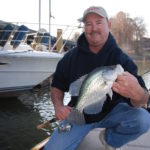
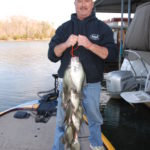
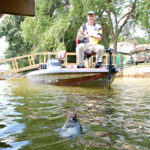
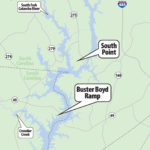

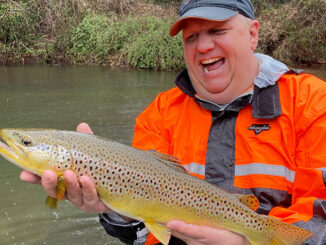


Be the first to comment